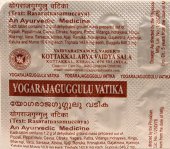Rasaratnasamuccaya, Rasaratna-samuccaya: 6 definitions
Introduction:
Rasaratnasamuccaya means something in Hinduism, Sanskrit. If you want to know the exact meaning, history, etymology or English translation of this term then check out the descriptions on this page. Add your comment or reference to a book if you want to contribute to this summary article.
Alternative spellings of this word include Rasaratnasamuchchaya.
In Hinduism
Ayurveda (science of life)
Rasashastra (Alchemy and Herbo-Mineral preparations)
Source: Ancient Science of Life: Critical Review of Rasaratna SamuccayaRasaratnasamuccaya (रसरत्नसमुच्चय) is a 13th century C.E. alchemical treatise, authored by Vāgbhaṭa, is a useful compilation related to preparation and properties of drugs of mineral and metallic origin. The Rasaratnasamuccaya is a precise treatise among available ancient literature. It comprises of all eight branches of Ayurveda, although it mainly deals with therapeutic aspects of Rasaśāstra and emphasizes the use of metals and minerals in treating nearly 68 types of ailments. It contains 30 chapters, 3871 verses and detailed description of 960 formulations. Classification of metals and minerals; description of some new instruments, formulations and averting use of metals and minerals in pregnancy are the key features of Rasaratnasamuccaya.
Unclassified Ayurveda definitions
Source: archive.org: Vagbhata’s Ashtanga Hridaya Samhita (first 5 chapters)Rasaratnasamuccaya (रसरत्नसमुच्चय) (“jewel accumulation of metallic preparations”) refers to one of the three great works of Vāgbhaṭa.—The Rasaratnasamuccaya is in some manuscripts attributed to one Nityanātha or Aśvinīkumāra.

Āyurveda (आयुर्वेद, ayurveda) is a branch of Indian science dealing with medicine, herbalism, taxology, anatomy, surgery, alchemy and related topics. Traditional practice of Āyurveda in ancient India dates back to at least the first millenium BC. Literature is commonly written in Sanskrit using various poetic metres.
General definition (in Hinduism)
Source: WikiPedia: HinduismRasaratna Samuccaya, (रसरत्न समुच्चय), is a scientific text written during the Tantric period in India. The text contains detailed descriptions of various complex metallurgical processes.
Languages of India and abroad
Sanskrit dictionary
Source: Cologne Digital Sanskrit Dictionaries: Aufrecht Catalogus Catalogorum1) Rasaratnasamuccaya (रसरत्नसमुच्चय) as mentioned in Aufrecht’s Catalogus Catalogorum:—med. B. 4, 236. Rādh. 32. Taylor. 1, 407.
—by Nityanātha Siddha. Burnell. 69^b. Agrees with the work attributed to Vāgbhaṭa. Quoted by Rāmasena in Rasasārāmṛta.
—by Nityānanda (?). Oppert. Ii, 6595.
—by Vāgbhaṭa (Bāhaṭa), son of Siṃhagupta. Io. 85. 1540. 2185. K. 216. Ben. 64. Bik. 656. Kāṭm. 13 (Rasavāgbhaṭṭa). Np. Viii, 62.
—by Siddharātrī (?). Khn. 88.
2) Rasaratnasamuccaya (रसरत्नसमुच्चय):—med. Gov. Or. Libr. Madras 74.
—by Vāgbhaṭa, son of Siṃhagupta. Bl. 236. Stein 187. The author, whoever he be, mentions in the beginning first a set of authors on medical chemistry, and then other names of writers whose works he professes to have made use of. Both are for the most part apocryphal.
3) Rasaratnasamuccaya (रसरत्नसमुच्चय):—med. by Vāgbhaṭa, son of Siṃhagupta. Ulwar 1664. Extr. 426.
Source: Cologne Digital Sanskrit Dictionaries: Monier-Williams Sanskrit-English DictionaryRasaratnasamuccaya (रसरत्नसमुच्चय):—[=rasa-ratna-samuccaya] [from rasa-ratna > rasa > ras] m. Name of [work]
[Sanskrit to German]
Sanskrit, also spelled संस्कृतम् (saṃskṛtam), is an ancient language of India commonly seen as the grandmother of the Indo-European language family (even English!). Closely allied with Prakrit and Pali, Sanskrit is more exhaustive in both grammar and terms and has the most extensive collection of literature in the world, greatly surpassing its sister-languages Greek and Latin.
See also (Relevant definitions)
Partial matches: Rasaratna, Samuccaya.
Full-text (+82): Vrintakamusha, Mahamusha, Samanyamusha, Gauripashana, Agnisaha, Svarnamakshika, Yama, Darada, Kanjika, Gagana, Pitakalka, Manahshila, Somala, Suta, Culhi, Dhusturapushpamusha, Dirghamusha, Kacakupi, Andhamusha, Pala.
Relevant text
Search found 4 books and stories containing Rasaratnasamuccaya, Rasaratna-samuccaya; (plurals include: Rasaratnasamuccayas, samuccayas). You can also click to the full overview containing English textual excerpts. Below are direct links for the most relevant articles:
Jivanandana of Anandaraya Makhin (Study) (by G. D. Jayalakshmi)
Rasa and Gandhaka—The Base of all Medicines < [Chapter 4 - Āyurvedic principles in Jīvanandana Nāṭaka]
Rasa Jala Nidhi, vol 5: Treatment of various afflictions (by Bhudeb Mookerjee)
Part 4 - Chemists of the Metallic School: Introduction < [A Brief History of Indian Chemistry and Medicine]
Atharvaveda and Charaka Samhita (by Laxmi Maji)
Caraka-Saṃhitā (Āyurveda book) < [Chapter 1 - Introduction]
Cosmetics, Costumes and Ornaments in Ancient India (by Remadevi. O.)
1.1. Materials (b): Silver < [Chapter 3 - Ornaments]
1.1. Materials (a): Gold < [Chapter 3 - Ornaments]
Related products
